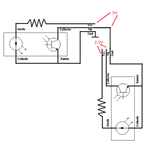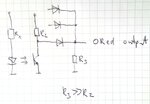Lilithet
Newbie level 4

So I looted a bunch of optical endstops from a printer, and wanted to use them as limiter switches, but to do this I need to connect two of them to one output pin, as seen below. Unfortunately I can't figure out what I am doing incorrectly. When I measure signal to VCC I get a full 5V but when I chain them as seen in the diagram, I only get 2.5V. I don't understand why this is happening, nor how to fix this issue.
Any help would be appreciated.

Any help would be appreciated.



